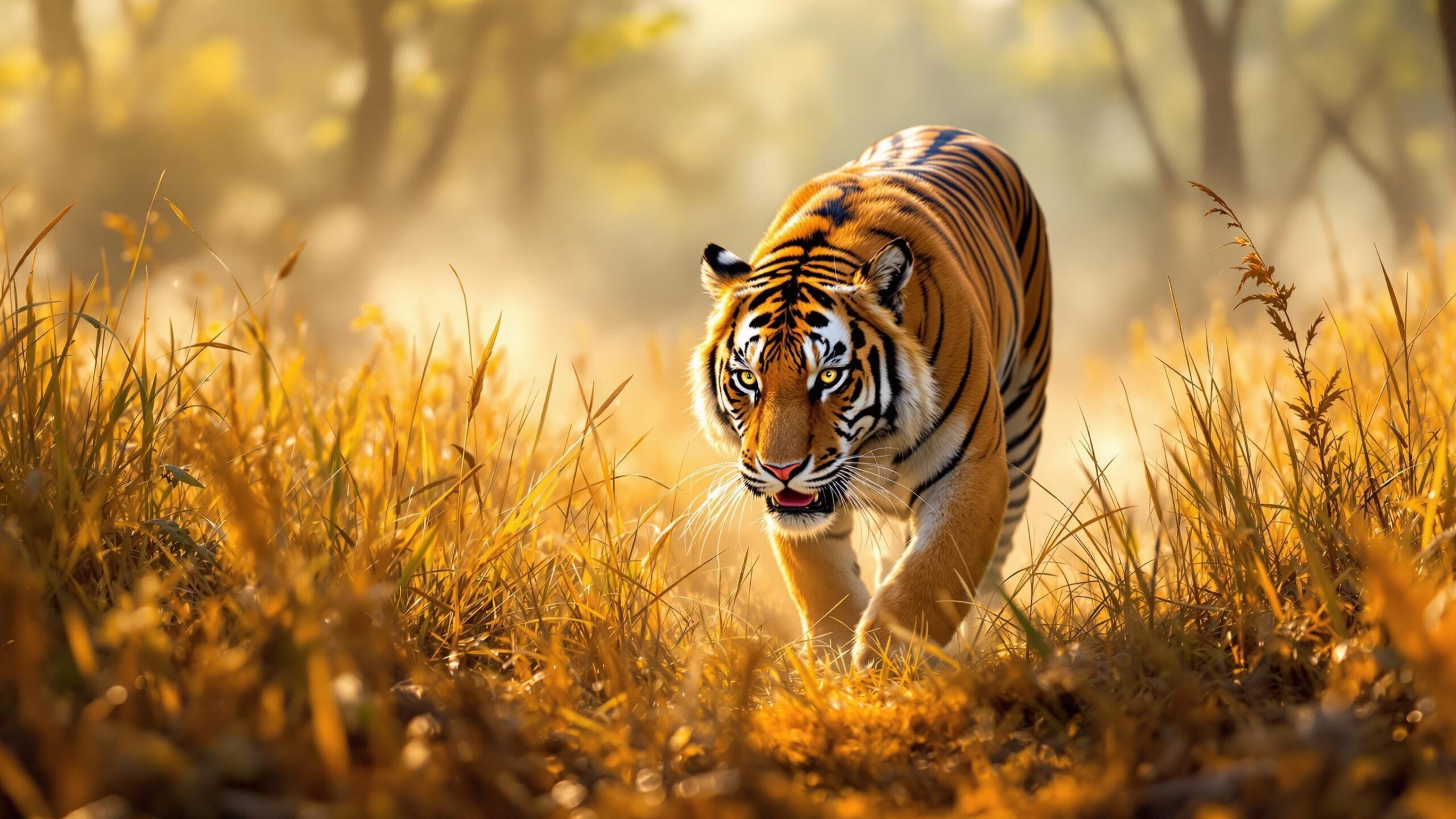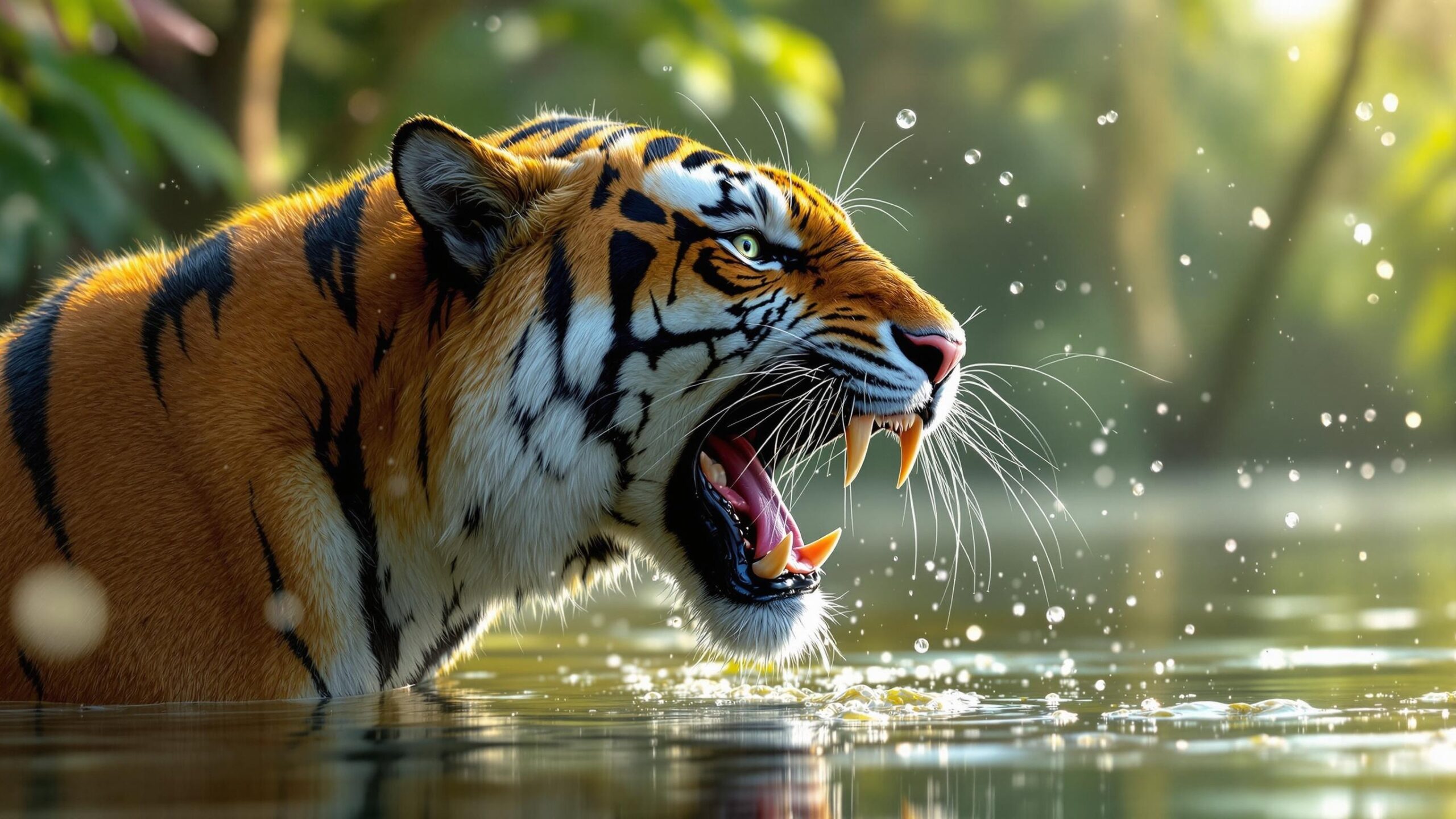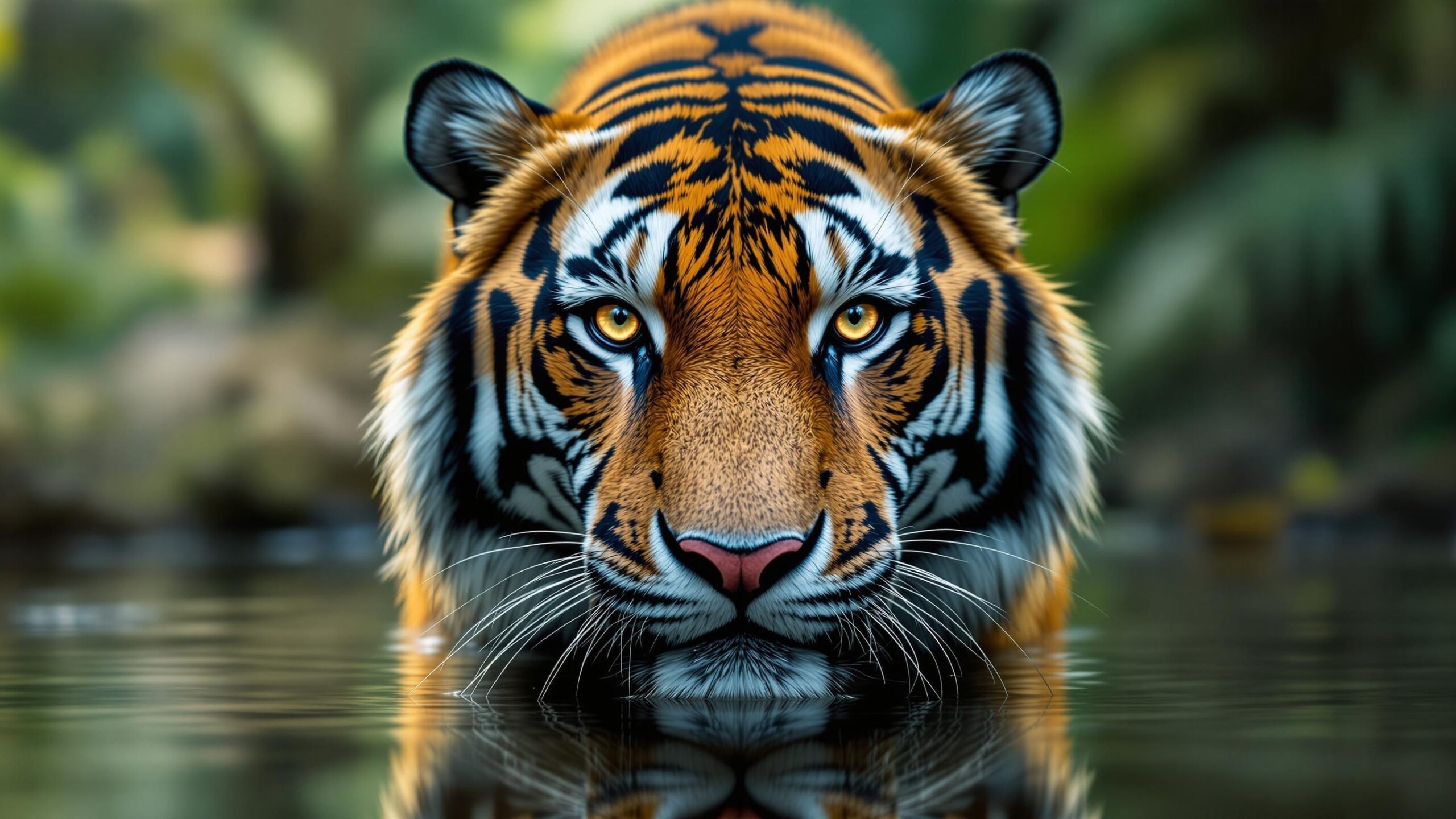Bengal Tiger: The Striped Monarch of the Indian Wild
The Bengal tiger, scientifically known as Panthera tigris tigris, reigns supreme as one of the most iconic and majestic animals on Earth. Native to the Indian subcontinent, this powerful feline has captivated imaginations for centuries with its raw beauty, fierce strength, and enigmatic presence in the dense forests, grasslands, and mangroves it calls home. With its brilliant orange coat adorned by jet-black stripes, the Bengal tiger is not only a marvel of evolutionary design but also a symbol of wilderness, strength, and cultural heritage.
As the most numerous tiger subspecies, the Bengal tiger represents the best-known image of the global tiger population. Yet despite its fame and relative abundance compared to other subspecies, it faces complex challenges in a rapidly modernizing world. This article explores the biology, behavior, habitat, cultural impact, and conservation context of the Bengal tiger, delivering an engaging and accessible guide for anyone fascinated by one of nature’s most legendary predators.
The Physical Majesty of the Bengal Tiger
Among the largest members of the cat family, the Bengal tiger is a muscular and imposing carnivore. Adult males typically weigh between 400 and 570 pounds and can measure up to 10 feet in length, including the tail. Females are slightly smaller, generally ranging from 250 to 350 pounds and measuring about 8 feet. Their powerful limbs, massive paws, and strong jaws make them apex predators built for stealth and dominance.
Their fur is typically a rich orange with distinct black stripes that run vertically along the body, although no two tigers share the same pattern. The underbelly is white, and the face often features white markings around the eyes and cheeks, which may serve to enhance visual communication in the dense foliage. Rare white Bengal tigers, which lack the typical orange pigmentation, have also appeared in the wild and captivity due to a recessive genetic trait.
Habitat: The Diverse Territories of the Bengal Tiger
The Bengal tiger thrives in a variety of habitats across the Indian subcontinent, including tropical rainforests, subtropical moist deciduous forests, mangroves, grasslands, and even dry scrub forests. India hosts the largest population, with smaller groups found in Bangladesh, Nepal, Bhutan, and parts of western Myanmar. One of the most unique and fascinating habitats is the Sundarbans, a vast mangrove delta straddling India and Bangladesh. Here, Bengal tigers have adapted to a semi-aquatic lifestyle, swimming across wide tidal rivers and hunting in muddy terrain.
The tiger’s vast range is a confirmation to its adaptability, but it also reveals the challenges it faces. As human populations expand and industrialization continues, tiger habitats are increasingly fragmented, forcing these solitary animals to traverse dangerous, human-dominated landscapes in search of food and mates.
Solitary Hunters with a Stealth Advantage
Bengal tigers are solitary creatures, each occupying a territory that varies in size based on the availability of prey and landscape features. Male territories may overlap with those of several females, but they generally avoid contact with other males. Tigers mark their territory with scent markings, scratch marks, and vocal roars that can be heard up to two miles away.
Their hunting technique is built on stealth, patience, and explosive power. Tigers prefer to stalk their prey quietly, using dense vegetation as cover. Once close enough—often within 20 to 30 feet—they unleash a rapid charge and aim for the neck or throat to deliver a fatal bite. Their diet primarily consists of large herbivores such as deer, wild boar, water buffalo, and antelope. In some areas, particularly where their natural prey is scarce, tigers may target livestock, leading to conflicts with local communities. Despite their size and power, tigers have a relatively low hunting success rate and must rely on multiple attempts to secure a meal. After a kill, a tiger may drag its prey into a secluded area and feed for several days, covering the carcass with leaves or dirt between meals to keep scavengers at bay.
Reproduction and the Tiger Life Cycle
The mating season for Bengal tigers typically peaks between November and April, although they can breed year-round. Courtship involves scent marking, vocalizations, and brief periods of companionship. After mating, the male usually leaves, and the female assumes full responsibility for raising the cubs.
Gestation lasts about 3.5 months, resulting in a litter of two to four cubs, though sometimes more. Cubs are born blind and helpless, relying on their mother for warmth, protection, and milk. By two months of age, they begin eating meat, and by six months, they start accompanying their mother on hunts, learning the skills necessary to survive on their own. Cubs usually remain with their mother until they are 18 to 24 months old, at which point they disperse to find their own territories. The juvenile period is fraught with danger. Many cubs fall victim to predation, starvation, or other natural hazards before reaching adulthood. However, those that survive grow into formidable hunters, continuing the cycle of one of Earth’s most powerful species.
Bengal Tiger Behavior and Intelligence
Bengal tigers are not only physically impressive but also exhibit complex behaviors and problem-solving abilities. They communicate using a variety of vocalizations, body postures, and scent markings. Roars, growls, moans, chuffing sounds (a non-threatening greeting), and hisses are part of their rich vocal repertoire. Roaring is often a way to announce territory or deter rivals, while softer sounds like chuffing occur between mothers and cubs or courting pairs.
These tigers are known for their intelligence and adaptability. In captivity, they can learn tasks, solve puzzles, and respond to commands, demonstrating keen memory and observational skills. I n the wild, they’ve been observed modifying their hunting strategies based on terrain, prey behavior, and even human presence. Their ability to adapt behaviorally is one reason they’ve persisted despite the immense pressures they face.
Cultural Significance and Mythic Symbolism
The Bengal tiger has loomed large in human culture for millennia. It is the national animal of India and Bangladesh and features prominently in art, folklore, literature, and religious symbolism throughout South Asia. In Hindu mythology, the goddess Durga is often depicted riding a tiger, representing strength, power, and protection against evil. From ancient Indian epics to modern novels, poems, and films, the tiger’s image has symbolized royalty, danger, mystery, and the untamed forces of nature. In more practical terms, the tiger has also been a focal point for eco-tourism and wildlife awareness campaigns, serving as a flagship species for broader conservation efforts.
Conservation: Hope, Challenges, and Responsibility
While the Bengal tiger is the most numerous of all tiger subspecies, it is still classified as Endangered on the IUCN Red List. The global Bengal tiger population is estimated to be between 2,500 and 3,000 individuals in the wild. This number has shown signs of recovery in some regions, particularly India, which has implemented aggressive conservation measures, but threats remain. Habitat destruction, poaching, prey depletion, and human-wildlife conflict are among the tiger’s most persistent dangers. Illegal trade in tiger parts, driven by demand in traditional medicine and the exotic pet market, continues despite international bans. Encroachment by human settlement and agriculture has also led to increasing encounters between tigers and villagers, often ending in tragedy for both parties.
India’s Project Tiger, launched in 1973, has been one of the most successful conservation programs globally, establishing over 50 tiger reserves across the country. In some areas, innovative strategies such as wildlife corridors, community conservation programs, and anti-poaching technologies like camera traps and drones are yielding positive results. However, true long-term success will depend not just on governmental action but also on local community involvement and international support. Preserving the Bengal tiger isn’t just about saving a single species—it’s about protecting entire ecosystems and promoting harmony between people and wildlife.

Bengal Tigers in Captivity: Challenges and Ethical Questions
There are thousands of Bengal tigers in captivity around the world, especially in zoos, sanctuaries, and even private collections. Captive tigers are often used for breeding, conservation education, and public engagement, but these practices raise important ethical and ecological questions. Captive breeding programs can help preserve genetic diversity and create insurance populations in case of extinction in the wild. However, not all captive environments are beneficial to tigers. Poorly regulated facilities may breed tigers irresponsibly, fail to provide adequate space or enrichment, and contribute to the black-market trade in tiger parts.
Accredited zoos and conservation centers, on the other hand, can play a critical role in education and awareness, connecting people to the realities of tiger conservation. These institutions also participate in international breeding and research programs that contribute valuable knowledge to in-situ (wild) conservation efforts.
Famous Bengal Tigers in History and Media
Over time, certain Bengal tigers have become iconic, either for their extraordinary stories or their role in popular culture. One famous example is Machli, the “Queen of Ranthambore,” a legendary tigress in India’s Ranthambore National Park. Machli became famous for her hunting prowess, her unusual longevity (living over 18 years), and for being the star of numerous documentaries. Her genetic legacy continues through many of the tigers in the park today. In literature and film, Bengal tigers have also taken center stage. Perhaps the most well-known fictional tiger is Richard Parker from Yann Martel’s novel Life of Pi, which explores themes of survival, fear, and the human-animal connection. This portrayal brought global attention to the tiger’s mystery and majesty, emphasizing its symbolic and narrative power.
What Makes the Bengal Tiger Unique?
What sets the Bengal tiger apart is not just its size, beauty, or ecological role—it’s the delicate balance it represents. It’s a predator that relies on the integrity of entire ecosystems to survive. It’s a solitary hunter that shapes prey populations and influences the behavior of other species. It’s also a cultural touchstone, evoking respect, awe, and a call to responsibility.
Among the tiger subspecies, the Bengal tiger is unique in how it bridges wildness and proximity to people. Nowhere else do tigers and humans live so closely together, especially in India, where ancient traditions and modern pressures co-exist. The Bengal tiger thus becomes a symbol not just of nature, but of humanity’s evolving relationship with the natural world.
A Call to Explore and Protect
Learning about the Bengal tiger is more than a journey into zoology—it’s a pathway into understanding the pulse of the wild. Every fact, behavior, and story about this incredible animal leads to deeper questions about our place in the ecosystem and our ability to preserve it. For those fortunate enough to witness a Bengal tiger in the wild, the experience is unforgettable. But even from afar, we can all play a role—through education, advocacy, responsible tourism, and supporting conservation organizations that protect tiger habitats and wildlife corridors. The Bengal tiger stands at a crossroads between survival and extinction. Its future hinges on what we choose to value: convenience or coexistence, profit or preservation, indifference or action. By respecting and protecting this magnificent creature, we ultimately protect something much larger—our shared natural heritage and the planet we all call home.


